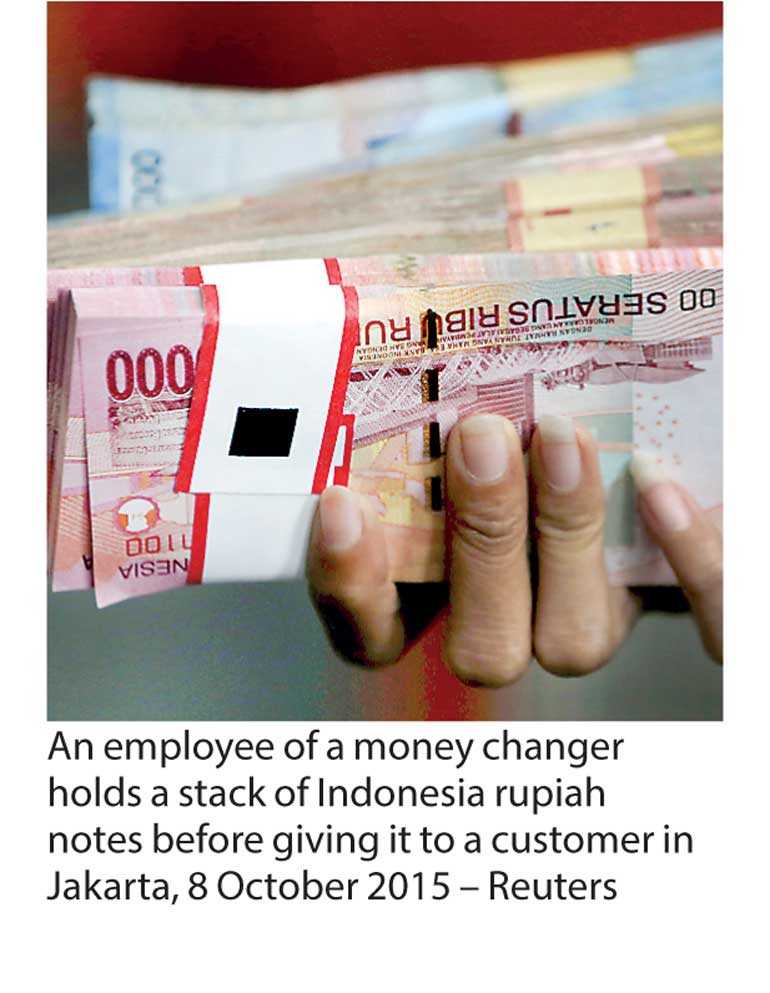Thursday Mar 06, 2025
Thursday Mar 06, 2025
Friday, 4 May 2018 00:00 - - {{hitsCtrl.values.hits}}
 Reuters: Investors trimmed their positions on most emerging Asian currencies in the last two weeks, a Reuters poll showed, following recent strength in the dollar on signs of resilience in the US economy and a rise in Treasury yields.
Reuters: Investors trimmed their positions on most emerging Asian currencies in the last two weeks, a Reuters poll showed, following recent strength in the dollar on signs of resilience in the US economy and a rise in Treasury yields.
US debt yields surged over the past two weeks on a sell-off in the bond market, while robust economic data in the United States, pulled the rug out from under riskier asset classes.
The Federal Reserve on Wednesday indicated that inflation was nearing the central bank’s target, and that it remained on track to raise borrowing costs in June.
As such, the dollar gained against a basket of currencies, underpinned by the Fed’s upward path for its benchmark interest rate.
A stronger dollar bodes poorly for Asian currencies, as it will lure capital from the region’s volatile markets to relatively safer assets in the United States.
A poll of 12 analysts reflected the shift in portfolios, as positions on most Asian currencies were pulled back.
Bearish bets on the Indian rupee surged to their highest since August 2013, reflecting recent concerns about sustainable growth in the country.
India’s infrastructure growth slowed to a three-year low of 4.2% in the fiscal year ending in March, indicating Prime Minister Narendra Modi faces a tough challenge to boost investment ahead of general elections due early next year.
Bullish bets on the Singapore dollar fell to their lowest since November 2017. The currency shed about 1.1% to the dollar in April, its worst month since November 2016.
The city-state’s fundamentals remain strong, however, with factory output growing more than expected in March while Singapore’s Prime Minister Lee Hsien Loong painted a rosier picture of economic performance for 2018 this week.
Positions on the Taiwan dollar turned bearish after more than nine months, cementing a recent downturn in the currency. The Taiwan dollar saw April as its worst month in more than two years, and is poised to lose in May as well.
An expected slowdown in global tech demand has also fuelled speculation about whether recent strong growth in the technology sector can be sustained, as Taiwan’s GDP growth slowed in the first quarter of 2018.
Bearish bets on Indonesia’s rupiah surged to their highest since November 2016, as it bore the brunt of a yield prompted sell-off. The rupiah is subject to a large amount of foreign exposure, with data from Bank Indonesia showing that foreigners held about 39% of Indonesian government bonds as at the end of March.
Indonesia’s central bank has said it would intervene in the market if volatility in the rupiah got out of hand.
On the other hand, bullish bets on the South Korean won rose, as easing political tensions with its Northern neighbour reaffirmed confidence in the country.
The leaders of North and South Korea signed a declaration last week agreeing to work for the “complete denuclearisation of the Korean peninsula,” a pledge of peace following about six decades of conflict.
The news comes as a great relief for South Korean markets, which were rattled by escalated tensions following a barrage of missile tests by North Korea last year.
The Asian currency positioning poll is focused on what analysts and fund managers believe are the current market positions in nine Asian emerging market currencies the Chinese yuan, South Korean won, Singapore dollar, Indonesian rupiah, Taiwan dollar, Indian rupee, Philippine peso, Malaysian ringgit and the Thai baht.
The poll uses estimates of net long or short positions on a scale of minus 3 to plus 3. A score of plus 3 indicates the market is significantly long US dollars.
The figures include positions held through non-deliverable forwards (NDFs).
Discover Kapruka, the leading online shopping platform in Sri Lanka, where you can conveniently send Gifts and Flowers to your loved ones for any event including Valentine ’s Day. Explore a wide range of popular Shopping Categories on Kapruka, including Toys, Groceries, Electronics, Birthday Cakes, Fruits, Chocolates, Flower Bouquets, Clothing, Watches, Lingerie, Gift Sets and Jewellery. Also if you’re interested in selling with Kapruka, Partner Central by Kapruka is the best solution to start with. Moreover, through Kapruka Global Shop, you can also enjoy the convenience of purchasing products from renowned platforms like Amazon and eBay and have them delivered to Sri Lanka.
Discover Kapruka, the leading online shopping platform in Sri Lanka, where you can conveniently send Gifts and Flowers to your loved ones for any event including Valentine ’s Day. Explore a wide range of popular Shopping Categories on Kapruka, including Toys, Groceries, Electronics, Birthday Cakes, Fruits, Chocolates, Flower Bouquets, Clothing, Watches, Lingerie, Gift Sets and Jewellery. Also if you’re interested in selling with Kapruka, Partner Central by Kapruka is the best solution to start with. Moreover, through Kapruka Global Shop, you can also enjoy the convenience of purchasing products from renowned platforms like Amazon and eBay and have them delivered to Sri Lanka.